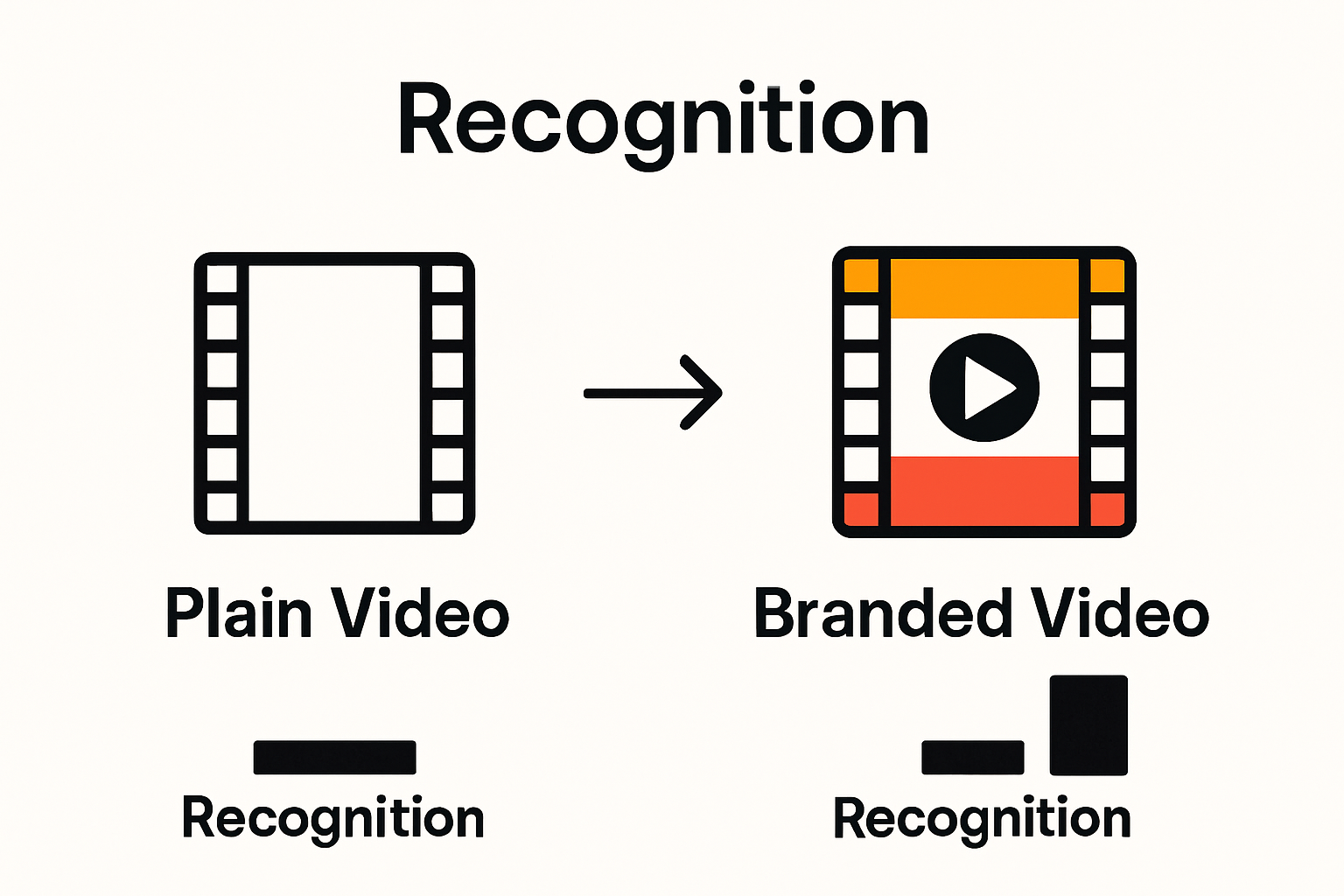What is Video Branding? Understanding Its Impact and Importance
- Pieter Nijssen
- Sep 9
- 7 min read

Video branding is redefining what it means to truly connect with an audience. Most people expect a commercial or flashy montage, but the real power of video branding is in its ability to generate an emotional response and shift perception. Studies show that video marketing improves memory retention of brand messages significantly more than text. There is a bigger story behind these visuals than meets the eye.
Table of Contents
Quick Summary
Takeaway | Explanation |
Video branding conveys brand identity effectively. | It transforms abstract corporate concepts into emotional and relatable visual stories, enhancing brand recognition. |
Consistent storytelling fosters audience trust. | Maintaining visual and narrative coherence helps build reliability and strong emotional connections with viewers. |
Engaging video content improves information retention. | Video branding communicates complex messages quickly, making it easier for audiences to remember key brand values. |
Authenticity in narratives strengthens engagement. | Crafting genuine stories that reflect brand identity leads to deeper connections and invited audience participation. |
Diverse sectors utilize tailored video strategies. | Different industries adopt unique storytelling techniques to resonate with their specific target audiences effectively. |
Defining Video Branding: What It Is and Its Purpose
Video branding represents a strategic approach to communicating a company’s identity, values, and messaging through visual storytelling. This powerful communication method goes beyond traditional advertising by creating immersive experiences that connect with audiences on emotional and intellectual levels. Learn more about our approach to corporate video branding.
The Core Essence of Video Branding
At its fundamental level, video branding transforms abstract corporate concepts into compelling visual narratives. It is not merely about producing promotional content but crafting a comprehensive visual language that represents an organization’s unique personality. According to research exploring marketing communication strategies, video branding helps organizations establish distinctive market positioning.
Key characteristics of effective video branding include:
Consistent visual and tonal representation
Clear communication of brand values
Emotional connection with target audiences
Strategic Purpose and Impact
Video branding serves multiple strategic objectives for businesses. It helps organizations build trust, increase brand recognition, and create memorable interactions with potential customers. By leveraging visual storytelling, companies can communicate complex messages quickly and engagingly. The process involves carefully selecting visual elements, narrative structures, and emotional triggers that resonate with specific audience segments.
Effective video branding goes beyond aesthetic appeal. It transforms how audiences perceive and interact with a brand, turning passive viewers into active participants in the brand’s narrative. This approach requires deep understanding of target demographics, organizational values, and contemporary visual communication techniques.
To provide a clear overview, the following table organizes the key elements that contribute to effective video branding and their specific roles.
Element | Description |
Consistent Visual Style | Uses a recurring color palette and styling to maintain brand unity. |
Authentic Brand Representation | Ensures visuals and narratives accurately reflect brand personality. |
Compelling Narrative Arc | Creates a storyline that captures and holds the viewer’s interest. |
Emotional Resonance | Triggers feelings that connect audiences to brand values. |
Technical Precision | Leverages high-quality visuals, sound, and editing for impact. |
Audience Insight | Incorporates understanding of target demographics into content. |
Visual Coherence | Aligns all design elements for a unified viewing experience. |
The Importance of Video Branding in Modern Marketing
Modern marketing demands innovative strategies that capture audience attention and create meaningful connections. Video branding has emerged as a powerful tool enabling businesses to communicate complex narratives quickly and emotionally. Explore our insights on visual branding strategies.
Digital Engagement and Consumer Behavior
In the digital era, consumer attention spans are increasingly fragmented. According to research on marketing communication strategies, video marketing provides a compelling medium to cut through information noise and directly engage target audiences.
Key advantages of video branding include:

Faster information transmission compared to text
Higher emotional resonance with viewers
Improved memory retention of brand messaging
Strategic Marketing Differentiation
Video branding transcends traditional advertising by creating immersive storytelling experiences. It allows organizations to showcase their unique personality, values, and mission through visual narratives. Successful video branding transforms companies from generic service providers into distinctive, memorable brands that audiences can relate to and trust.
By strategically developing video content that speaks directly to target demographics, businesses can create powerful emotional connections. These connections drive brand loyalty, increase engagement rates, and ultimately influence purchasing decisions more effectively than conventional marketing approaches.
Key Elements that Shape Effective Video Branding
Creating compelling video branding requires a strategic blend of technical skill, creative storytelling, and deep audience understanding. Organizations must carefully craft visual narratives that resonate authentically with their target demographics. Discover more about corporate visual identity strategies.
Visual Storytelling and Narrative Design
Successful video branding transforms complex organizational messages into engaging visual stories. According to research on commercial design principles, effective video content requires careful consideration of narrative structure, emotional triggers, and visual coherence.
Critical components of powerful video branding include:
Consistent color palette and visual styling
Authentic representation of brand personality
Clear and compelling narrative arc
Technical and Emotional Alignment
Video branding transcends mere technical execution. It demands a nuanced understanding of how visual elements interact with audience emotional landscapes. Successful brands create videos that not only communicate information but also generate meaningful connections through carefully curated visual experiences.
The most impactful video branding strategies integrate technical precision with genuine emotional storytelling. This approach requires deep audience insights, creative flexibility, and a commitment to representing the brand’s core values through every visual and narrative choice.
How Video Branding Connects with Audience Engagement
Audience engagement represents the critical bridge between brand messaging and meaningful consumer interactions. Video branding provides a sophisticated mechanism for transforming passive viewers into active participants in a brand’s narrative journey. Learn more about corporate communication strategies.
Psychological Dimensions of Visual Connection
Video content taps into deep psychological mechanisms of human perception and emotional processing. According to research examining audience engagement metrics, successful video branding triggers neurological responses that create lasting impressions far beyond traditional marketing approaches.
Key psychological engagement triggers include:
Narrative transportation that immerses viewers in brand stories
Emotional resonance through carefully crafted visual sequences
Sensory stimulation that activates multiple cognitive channels
Interactive Storytelling and Audience Participation
Modern video branding transcends one directional communication. By creating interactive and relatable visual experiences, brands invite audiences to become co-creators of meaning. Effective video strategies generate content that prompts viewers to reflect, share, and emotionally invest in the brand’s broader narrative.
The most compelling video branding approaches recognize that engagement is not about manipulation but genuine connection. They craft visual stories that respect audience intelligence, reflect authentic brand values, and create meaningful dialogues that extend beyond traditional marketing boundaries.

Real-World Examples of Successful Video Branding Strategies
Successful video branding transforms abstract marketing concepts into tangible, memorable experiences that resonate deeply with target audiences. By examining strategic approaches across industries, organizations can uncover powerful techniques for creating compelling visual narratives. Explore innovative video content strategies.
Strategic Content Development Approaches
According to research analyzing brand video content strategies, successful video branding emerges through carefully constructed storytelling that transcends traditional promotional tactics. Organizations increasingly leverage what researchers term ‘branded factual’ content—authentic stories told through genuine protagonists.
Key characteristics of effective video branding strategies include:
Authentic narrative representation of brand values
Emotional resonance with target audience
Clear and compelling storytelling structure
Industry Specific Video Branding Techniques
Different sectors demonstrate unique approaches to video branding. Technology companies often utilize sleek, innovation-focused narratives, while educational institutions emphasize human connection and transformative experiences. Successful strategies recognize that video content must reflect not just product features, but deeper organizational identity and cultural positioning.
The most compelling video branding examples demonstrate an ability to move beyond simple product promotion. They create immersive experiences that invite viewers to connect with the brand’s broader mission, values, and human dimension. By prioritizing authentic storytelling over direct sales messaging, these strategies build long term audience trust and engagement.
Unlock the Power of Video Branding for Your Business
Are you struggling to capture your audience’s attention or communicate your brand’s story in a meaningful, memorable way? As highlighted in the article, video branding is more than just a trend. It is a strategic necessity for building trust, emotional connection, and distinctiveness in today’s crowded digital market. If you’re ready to stand out with visually compelling narratives, Tulip Films delivers tailored video solutions that reflect your identity and engage your viewers on a deeper level. See how we approach corporate video branding.

Don’t risk becoming another forgettable brand. Partner with Tulip Films to transform your organizational values and unique personality into dynamic, high-quality videos that truly resonate. Explore our portfolio of impactful projects, and contact us today for a free consultation. Now is the perfect time to harness the full potential of video branding and make your message unforgettable.
Frequently Asked Questions
What is video branding?
Video branding is a strategic approach that uses visual storytelling to communicate a company’s identity, values, and messaging, creating emotional connections with audiences.
Why is video branding important in modern marketing?
Video branding is important because it captures audience attention quickly, enables deeper emotional engagement, and enhances brand recognition in a crowded digital marketplace.
How does video branding differ from traditional advertising?
Video branding focuses on immersive storytelling and emotional connections rather than simplistic promotion, transforming viewers into active participants in the brand’s narrative rather than just passive consumers.
The table below compares video branding with traditional advertising to help clarify their differences in strategy and outcome.
Aspect | Video Branding | Traditional Advertising |
Primary Focus | Emotional storytelling and audience connection | Direct promotion of products or services |
Communication Style | Immersive, narrative-driven | Informative, message-driven |
Audience Role | Active participants in the brand narrative | Passive recipients of information |
Impact on Perception | Builds trust and brand loyalty through authentic stories | Aims for immediate awareness or conversion |
Retention Approach | Engages emotions to improve message memory | Relies on repetition or simple messaging |
What elements should be included in effective video branding?
Effective video branding should include a consistent visual style, authentic representation of brand values, and a compelling narrative arc that resonates with the target audience.
Recommended